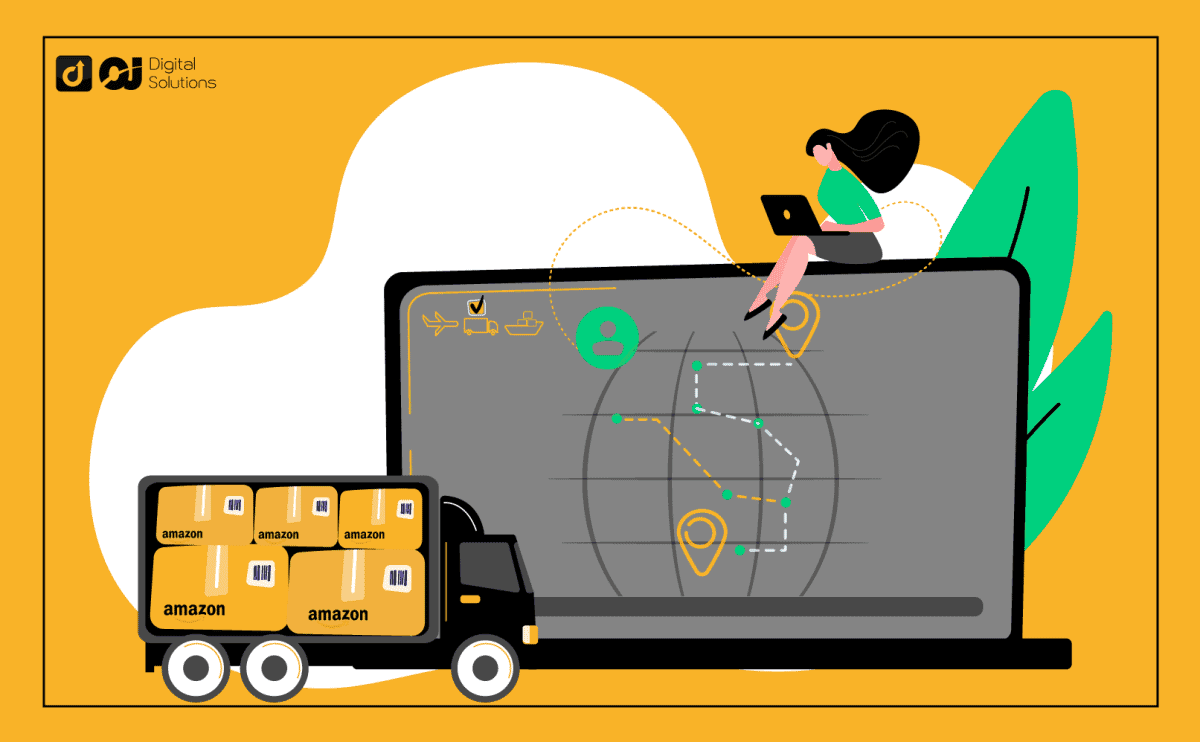If you’re an Amazon seller, then you’re probably familiar with the term “direct fulfillment.” But what does that actually mean? And more importantly, what are the benefits of using direct fulfillment?
In this blog post, I will answer all of your questions about Amazon Direct Fulfillment.
I’ll cover what it is, how it works, and the pros and cons of using this service. By the end of this article, you’ll have a clear understanding of whether or not direct fulfillment is right for your entire business.
Keep reading to learn more.
What Is Amazon Direct Fulfillment?
Direct Fulfillment on Amazon is a service that allows sellers to ship products to customers directly, rather than using Amazon’s fulfillment centers.
This can be a great option for Amazon sellers who want more control over their inventory and shipping process.
For example, if you sell items that are easily damaged or require special handling, then you might want to ship them yourself to make sure they arrive in perfect condition.
For Amazon vendors, Direct Fulfillment is an alternative fulfillment choice.
An online retailer can use this service as a stand-alone fulfillment solution or as a backup shipping method in addition to their main fulfillment service like Fulfillment by Amazon. Amazon Dropship Central was the previous name of the program.
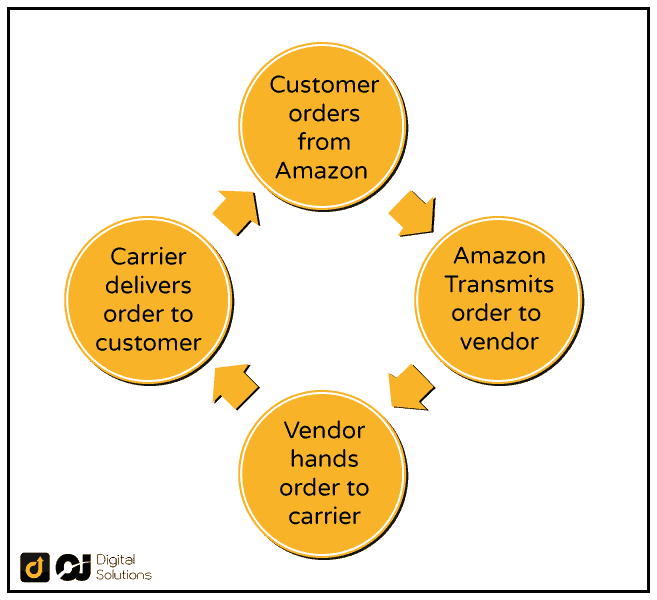
How Does Direct Fulfillment Work?
If you’re using Direct Fulfillment on Amazon, then you will be responsible for shipping products to customers yourself. This means that you will need to have your own products warehouse as well.
You’ll also need to create shipping labels on Amazon and attach them to each product before sending it out. When a customer places an order on Amazon, you’ll receive a notification and you can then pack and ship the product to them.
How Does Dropshipping Work on Amazon?
Dropshipping on Amazon enables vendors to sell goods, bundles, and packages to Amazon customers without having to deliver the inventory to Amazon fulfillment centers.
Two touch points are eliminated from the process with the Direct Fulfillment model, thus significantly lowering the number of damaged goods and wrong shipments.
The manufacturer never bargains with carriers or customers, Amazon never stores the product, and customers are more likely to be pleased with the finished product.
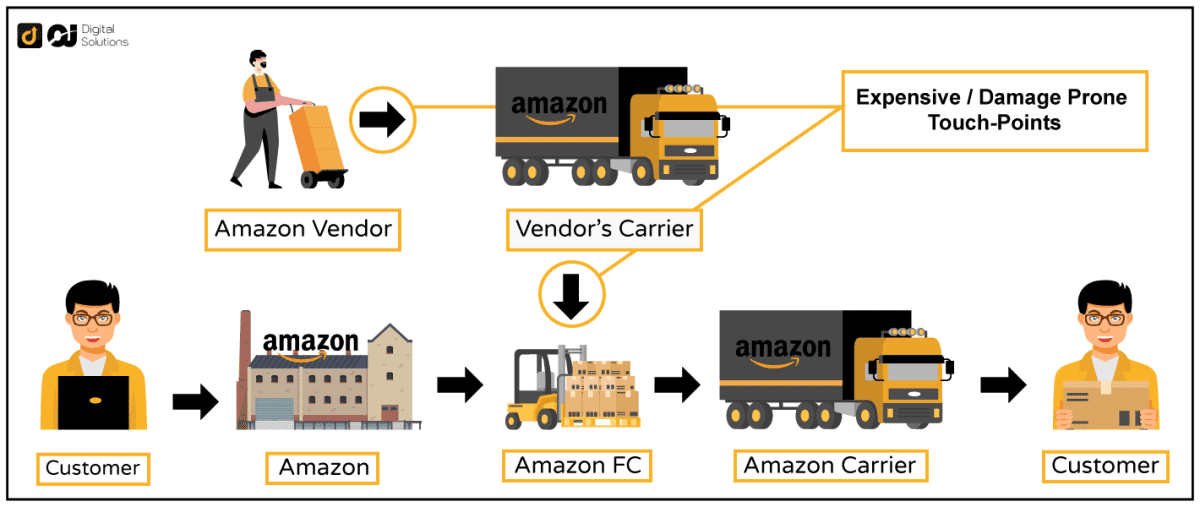
It’s important to note that you will still be responsible for meeting Amazon’s shipping guidelines and deadlines.
You’ll need to have a reliable shipping process in place to make sure that products are delivered on time.
Although the vendor or manufacturer ships the item to the customer, Amazon is responsible for the shipping costs. They also set the shipping deadlines that vendors must meet.
Below is a quick explanation of an Amazon dropshipping business process in 3 steps:
- A customer purchases items on their Amazon account.
- Amazon submits a similar purchase order to the supplier or manufacturer.
- Supplier sends the item directly to the customer, and Amazon covers the cost of shipping.

Pros Of Direct Fulfillment
Benefits of using Direct Fulfillment, include:
- More control over your inventory: When you use Amazon’s fulfillment centers, you have to send them your products and then hope that they arrive in good condition.
With direct fulfillment, you can ship products yourself and make sure that they’re well-packaged and have proper packing slips before sending them out.
- More control over your shipping process: With Direct Fulfillment, you can choose your own retail arbitrage, shipping methods and carriers.
This means that you can find the most efficient and cost-effective way to ship products to customers.
- Better customer service: When you ship products yourself, you have more control over the quality of customer service and processing customer returns.
You can make sure that customers are happy with their purchase and that they receive their products in a timely manner.
- There’s no need to use Amazon’s fulfillment centers: One of the main benefits of using Direct Fulfillment for your ecommerce store is that you don’t have to use Amazon’s fulfillment centers in your sales channel.
This can save you money on shipping fees and warehouse cost of storage, thus bettering your profit margins.
- Less or no damage to fragile products: When you ship products yourself, you can take more care of the external packaging on customer orders.
There’s less chance of products being damaged in transit. There is also no need for Amazon to handle your products, which can reduce the risk of damage.
- Flexibility: It gives you the flexibility to ship products to customers from multiple locations based on the search volume and inventory levels.
This can be helpful if you have a large inventory and want to be able to ship products from different warehouses or multiple suppliers depending on customer location.
Cons Of Direct Fulfillment
There are a few drawbacks to using Direct Fulfillment, including:
- You have to ship products yourself: You’ll need to have your own dropshipping products, warehouse and shipping process in place. You’re also responsible for meeting Amazon’s shipping deadlines and guidelines. It will be crucial to have a reliable shipping process and contact suppliers.
- You’re responsible for customer service: If there are any issues with a purchase or your supply chain, you’ll need to handle customer service yourself. This can be time-consuming and may require additional staff.
- You have to pay for shipping: Amazon will reimburse you for the cost of shipping, but you’ll still need to pay for shipping upfront. You might find this costly if you’re shipping products to customers around the world. And it might affect your sales channels as a result.
- You have to manage inventory: When you use Amazon’s fulfillment centers in online selling, they manage your inventory for you. With Amazon direct shipping, you’ll need to keep track of your own inventory and make sure that you have enough products in stock to meet customer demand when you drop ship on Amazon.
Who Can Sign Up For Amazon Direct Fulfillment?
If you’re a manufacturer, importer, or distributor of physical goods, you may be eligible to use Amazon Direct Fulfillment. You can sign up for Amazon Direct Fulfillment if you meet the following criteria:
- You have an Amazon business registered in the United States

- You have a warehouse in the United States

- You have the capacity to pick, pack, and ship orders to customers
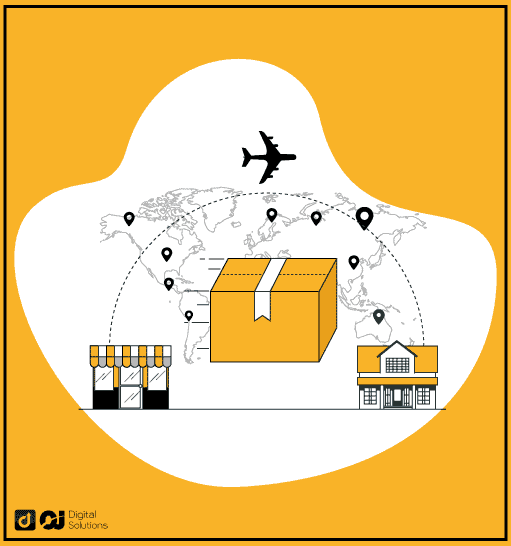
- You’re able to meet Amazon’s shipping deadlines
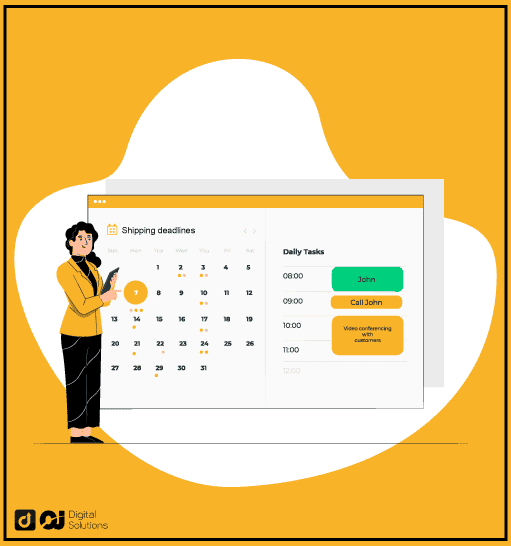
- Seller agreement to Amazon’s terms and conditions is necessary
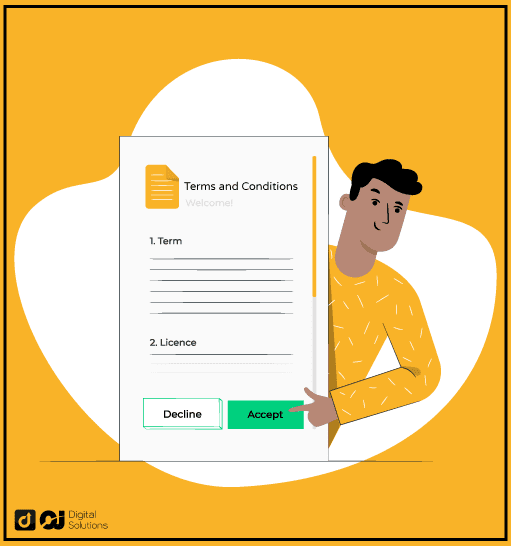
How To Set Up Vendor Central Direct Fulfillment
If you meet all of the above criteria, you can sign up for Direct Fulfillment by visiting your Amazon Vendor Central professional account.
After creating a product listing on Amazon, you’ll need to submit it to Amazon for approval.
Amazon will review your Amazon store listing to make sure it meets their guidelines. If it does, they’ll approve it and your product will be available for sale on their website.
In your Vendor Central amazon seller account, you can implement Direct Fulfillment.
Follow the on-screen instructions to enter your information and select your fulfillment settings by going to EDI > Direct Fulfillment. Amazon uses EDI (Electronic Data Interchange) for direct deposit payments. In the Direct Fulfillment program, it serves as a point of transfer for inventory data.
Amazon Direct Fulfillment Vs. Drop Shipping
When you’re trying to decide if Amazon Direct Fulfillment is right for your ecommerce business model, it’s helpful to compare it to other fulfillment options.
One common fulfillment method for wholesale suppliers is the dropshipping process.
Is Amazon dropshipping profitable? Yes it is. The dropshipping method is when you list and sell items on Amazon that are shipped directly from the dropshipping suppliers to the customer.
There are a few key differences between Amazon Direct Fulfillment and drop shipping:
- With Direct Fulfillment, you’re responsible for shipping products to customers. With drop shipping, the third party supplier ships products directly to customers.
- With Direct Fulfillment, you’re responsible for customer service. With drop shipping, the supplier is typically responsible for customer service.
- With Direct Fulfillment, you have to pay for shipping upfront. With drop shipping, the reliable supplier pays for shipping.
- With Direct Fulfillment, you manage inventory yourself. With drop shipping, the contact European suppliers are in charge of inventory management.
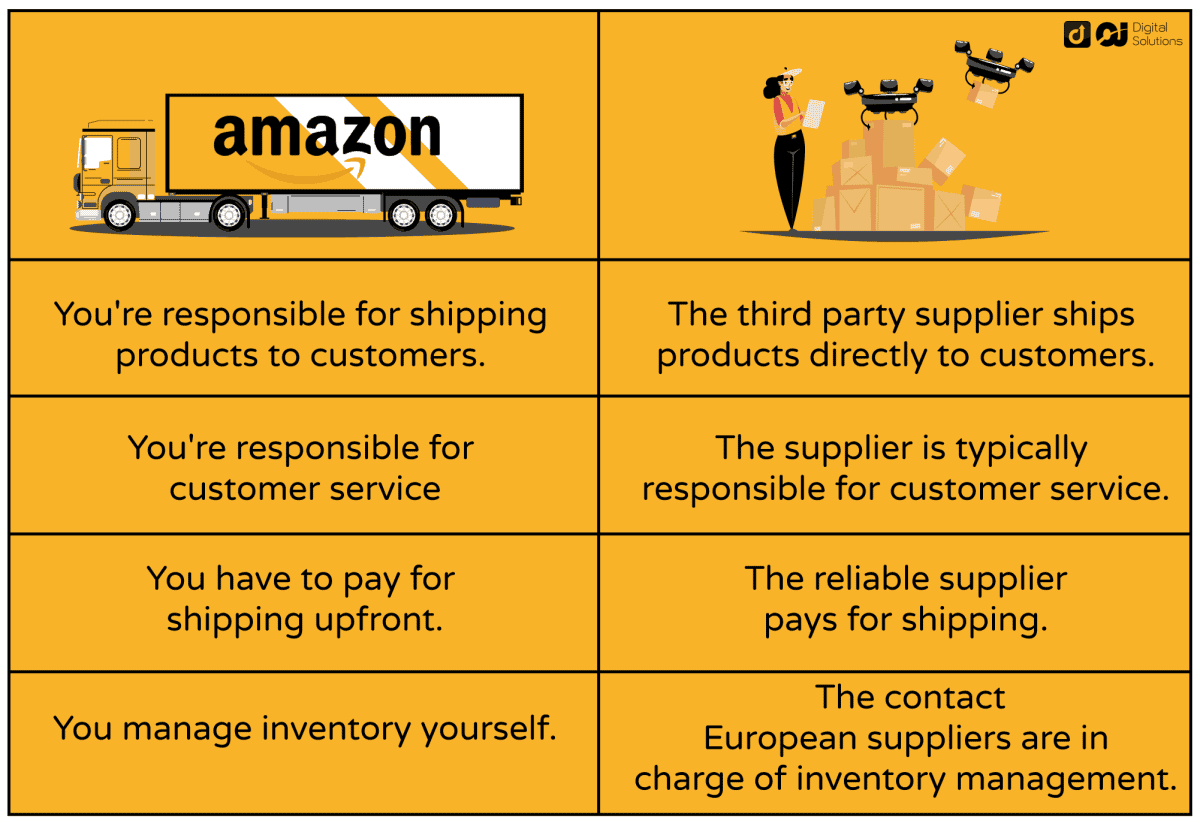
FAQ – Frequently Asked Questions
What Does It Mean When An Order Is In Fulfillment?
When an order is in fulfillment, it means that the order has been placed and the seller is in the process of shipping the product category to the customer.
This includes picking the products from inventory, packing them into boxes, and shipping them to the customer. The term “fulfillment” is often used interchangeably with “shipping” when you drop ship on Amazon.
Can You Sell Products Directly To Amazon?
Yes, you can. Vendor Central allows manufacturers and distributors to sell their products directly to Amazon.
When you sign up for Vendor Central, you create a product listing on Amazon. This listing includes information about your product, such as the price, quantity, and shipping details. Once your listing is approved by Amazon, your product will be available for sale on their website. If it does well, Amazon can start purchasing products from you.
What’s The Difference Between Amazon FBA And Amazon Direct Fulfillment?
The main difference between Amazon FBA and Amazon Direct Fulfillment is who is responsible for shipping products to customers. With Amazon FBA, Amazon ships products to customers on your behalf. With Direct Fulfillment, you’re responsible for shipping products to customers.
Another difference is that with Amazon FBA, you have to pay for shipping upfront. With Direct Fulfillment, the customer pays for shipping. Finally, with Amazon FBA, you manage inventory yourself. With Direct Fulfillment, the supplier manages inventory.
What Is A Direct Fulfillment Center?
A direct fulfillment center is a type of distribution center that ships goods and orders directly to customers. This is in contrast to a more traditional distribution center, which would ship goods to retailers who would then sell them to customers.
Direct fulfillment centers are often used by companies selling products from an online store, as they allow for a more streamlined fulfillment process.
In terms of Amazon, a direct shipment fulfillment center is a distribution center that takes care of shipping orders placed on an Amazon.com online store directly to customers, rather than to Amazon warehouses.
Takeaway
Amazon Direct Fulfillment is a great option for an online business that wants to sell on Amazon.
It’s important to understand the key differences between Amazon Direct Fulfillment and other fulfillment methods, such as drop shipping.
If you want more control over your fulfillment process and you’re willing to take on the responsibility of shipping products to customers, Amazon Direct Fulfillment is a good option for you.
If you’re not ready to take on that responsibility or if you want someone else to handle shipping, Amazon FBA could be your best bet.

